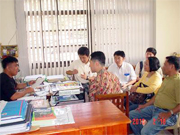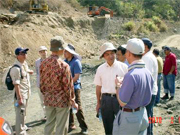- Home
- Technical Cooperation Projects
- Index of Countries
- Asia
- Philippines
- Strengthening the Flood Management Function of DPWH
- Project News
- Terminal Evaluation and 6th JCC Meeting (1)
Project News
2010-03-12
Terminal Evaluation and 6th JCC Meeting (1)
 Interview with Mayor of Sta. Fe Municipality
Interview with Mayor of Sta. Fe Municipality
The “Project for Strengthening the Flood Management Function of DPWH” will come to the end of the five-year cooperation in June 2010. For the purpose of the comprehensive verification of the accomplishments of the project compared to those planned, the terminal evaluation by the joint team which consists of Japanese and Filipino members was carried out from February 9 to February 25.
Evaluation Team members were as follows ;
- Team Leader:Mr. Shiro Nakasone Director, Disaster Management Division 1, Water Resource and Disaster Management Group, Global Environment Department, JICA
- Technical Advisor for Flood Control:Mr. Daisuke Kuribayashi, Public Works Research Institute
- Technical Advisor for Sabo:Mr. Masaru Tohei, MLITT
- Evaluation Planning:Mr. Wataru Ono, Deputy Assistant Director, JICA
- Evaluation Analysis:Mr. Hideyuki Kubo : Global Link Management Co., Ltd.
Also, two members from Philippine side joined into the Evaluation Team.
- Mr. Domingo C. Rosario, EngineerⅢ, Planning Service Department, DPWH
- Ms. Madelyn B. Loyola, EngineerⅢ, Planning Service Department, DPWH
The Team went on a tour of inspection to three Pilot Projects sites ; exchanged views with LGU (Local Government Unit) and DEO(District Engineering Office) ; interviewed counterparts (C/Ps) and Japanese experts ; and examined the various output data of achievements. Through this process, the Team grasped the achievement of the expected outputs in the whole project activities and gave the following findings as of the time of the terminal evaluation.
Output 1:Pilot Projects are implemented using the technical standards, guidelines and manuals. Inspection Tour to the Pilot Project Site(Sta.Fe River)
Inspection Tour to the Pilot Project Site(Sta.Fe River)
Three pilot projects have been implemented for the purpose of capacity building of engineers at FCSEC and DEO by applying TSG/Manual.
Two pilot projects (the Kinanliman River and the Digmala River) have already been completed and one (the Sta.Fe River) is currently under construction and will be completed by the end of the project.
It should be acknowledged that the case of the Kinanliman River is the very first experience of DPWH/FCSEC to develop M/P and F/S for Flood Control through the direct involvement of their engineers. The Sta.Fe case is the first hands-on experience for Sabo Dam construction.
Output 2:Research is conducted for developing/updating technical standard, guidelines and manuals; and assessing efficient countermeasures for flood control and sabo.- Recommendation on and revision/modifications/updating of technical standards, guidelines and manuals have been made through TWG (Technical Working Group) discussions.
- Based on actual field requirements, countermeasures have been recommended to concerned agencies.
- Various low cost flood control and sabo structures and technologies (e.g. soil cement) have been developed and utilized.
- Technical reports have been developed regarding usage/applicability of the technical standards, guidelines and manuals.
- Training on planning and design of flood control structures has been organized for participants from 111 DEO offices and their knowledge and skills were improved.
- Training on planning and design of sabo works engineering has been organized for participants from 45 DEO offices.
- Training on construction supervision of flood control and sabo projects has been organized for participants from 107 DEO offices and their knowledge and skills were improved.
- Training on maintenance of flood control and sabo structures projects has been organized for participants from 109 DEO offices and their knowledge and skills were improved.
- Flood control data throughout the country has been collected through the network of 138 DEOs and shared with organization in different sectors.
- Two seminars have been organized to share flood control and sabo management technologies with other related organizations.
- Database on flood control structures throughout the country has been operational and updated.
- Formal quarterly reports have been submitted to NEDA. Four newsletter has been issued.
- In the JCC meetings, suggestions have been made to DPWH that FCSEC permanency should be realizes. However, no resolution has been approved.
- In the rationalization process of DPWH, its management committee has reportedly agreed with the FCSEC permanency and submitted the proposal to DBM. However, no formal statement regarding the FCSEC permanency has been made by DPWH managements.
- No policies or regulations, which reflect the suggestion or proposal by FCSEC, have been issued at the national level regarding flood control.
- Several DEOs have been already utilized technical standards, guidelines and manuals produced by FCSEC.
- There are at least four cases that flood control and sabo structures were designed and constructed in accordance with the technical standards, guidelines and manuals produced by FCSEC.
- FCSEC proposed National Flood Management Framework Plan to NDCC, but the plan has not been launched.
- About JICA
- News & Features
- Countries & Regions
- Our Work
- Thematic Issues
- Types of Assistance
- Partnerships with Other Development Partners
- Climate Change / Environmental and Social Considerations
- Evaluations
- Compliance and Anti-corruption
- Science and Technology Cooperation on Global Issues
- Research
- JICA Development Studies Program / JICA Chair
- Support for the Acceptance of Foreign HRs / Multicultural and Inclusive Community
- Publications
- Investor Relations
